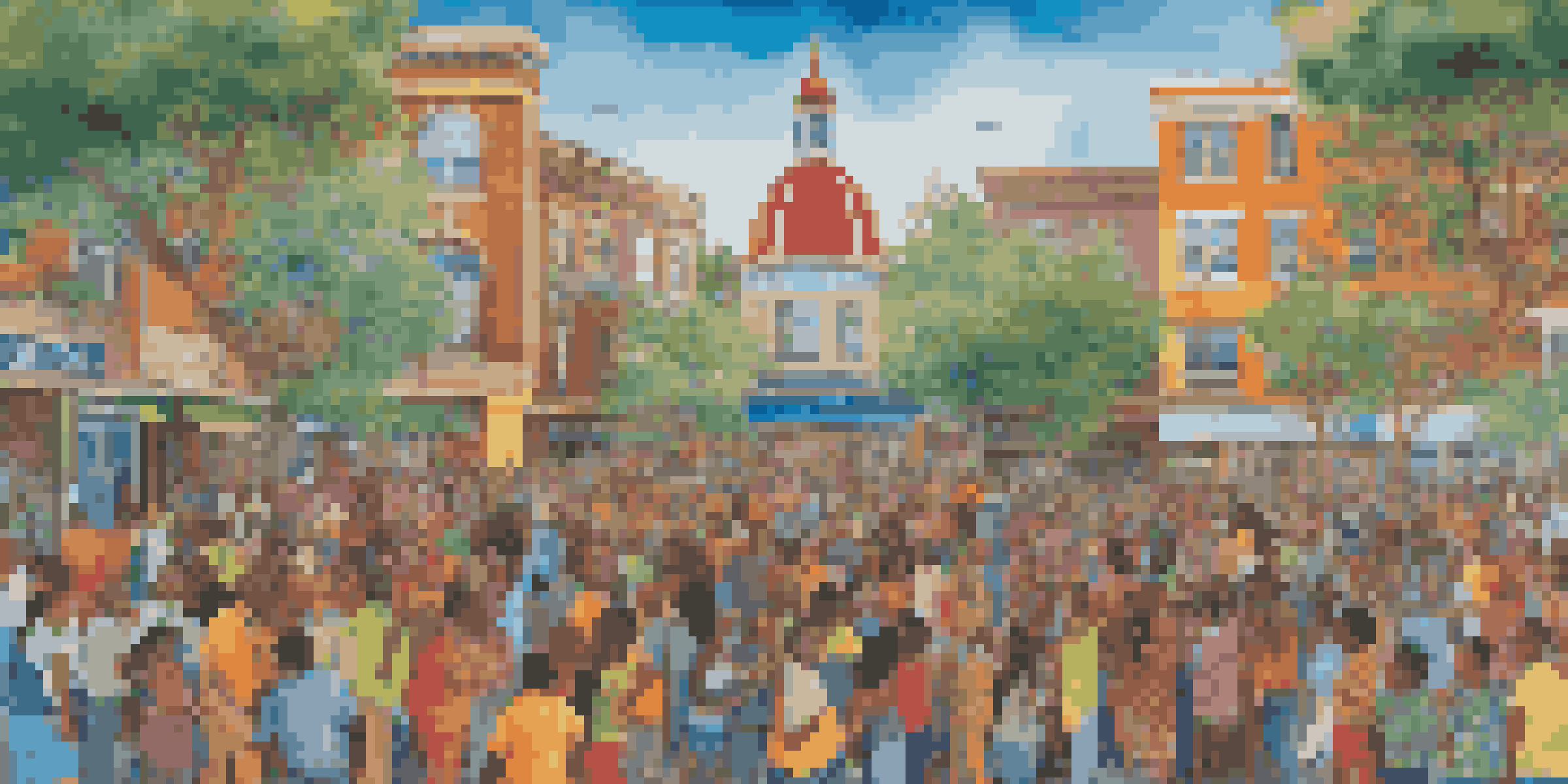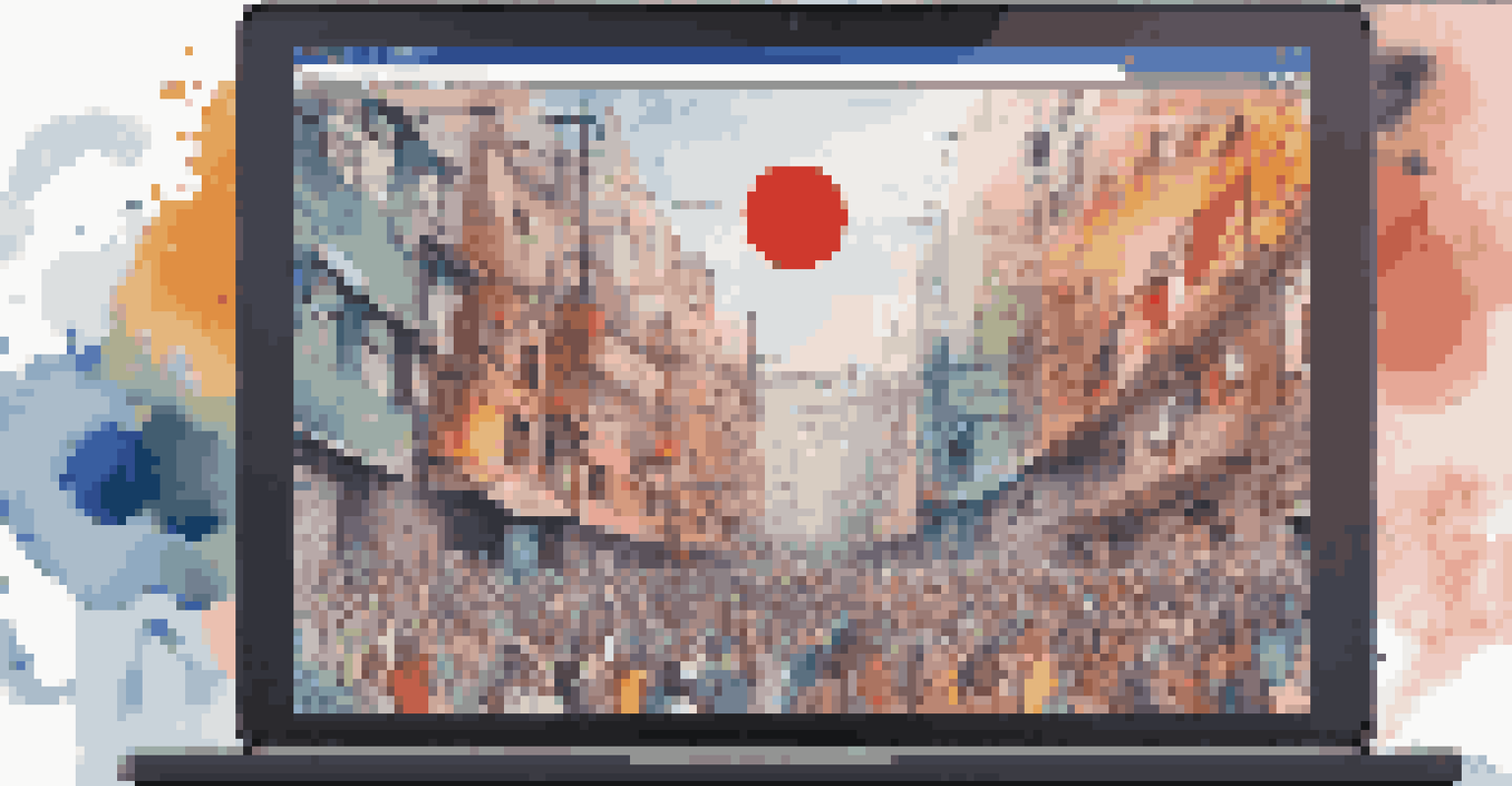Art as a Catalyst for Social Change and Community Resilience

Understanding the Role of Art in Society
Art has always been a mirror reflecting society's values, struggles, and aspirations. It not only captures moments in time but also challenges the status quo, prompting us to think critically about the world around us. By engaging with art, individuals can explore complex social issues, fostering deeper understanding and empathy within communities.
Art is not freedom from discipline, but disciplined freedom.
Moreover, art serves as a universal language, transcending barriers of culture and language. Whether through paintings, music, or theater, artistic expressions create shared experiences that unite people. This sense of connection is essential for building resilient communities that can navigate challenges together.
Ultimately, the role of art in society extends beyond aesthetics; it becomes a powerful tool for advocacy and change. As communities face social injustices, art can inspire movements, raising awareness and igniting conversations that lead to meaningful action.
Historical Examples of Art Driving Change
History is replete with examples of art acting as a catalyst for social change. Take, for instance, the powerful murals of the Mexican Revolution, which not only depicted the struggles of the people but also inspired national pride and unity. Similarly, the works of artists like Pablo Picasso, particularly his painting 'Guernica,' highlighted the horrors of war and sparked global conversations about peace and justice.

In the civil rights movement, music played a pivotal role in uniting individuals and spreading messages of hope and resilience. Songs like 'We Shall Overcome' became anthems, rallying people together in their fight against oppression. Such historical instances illustrate how art can mobilize communities and influence public perception.
Art Reflects and Shapes Society
Art serves not only as a reflection of societal values and struggles but also as a catalyst for critical thinking and social change.
These examples remind us that art is not just a passive form of expression; it can actively shape societal narratives and drive movements. When artists harness their talents to address pressing issues, they can inspire generations to advocate for change.
Art as a Tool for Healing and Resilience
In times of crisis, art emerges as a vital source of healing and resilience. Communities affected by trauma often turn to creative outlets for expression and catharsis. Whether it's through painting, writing, or music, the act of creating can provide solace and a sense of agency in the face of adversity.
Every artist was first an amateur.
Art therapy has gained recognition for its role in helping individuals process their emotions and experiences. By engaging in artistic practices, people can navigate their mental health journeys, fostering personal growth and resilience. This healing power of art extends beyond the individual, as shared creative experiences can strengthen community bonds.
Furthermore, public art installations and community art projects often serve as reminders of collective strength and unity. These artistic endeavors not only beautify spaces but also instill a sense of pride and belonging, contributing to the overall resilience of the community.
The Impact of Community Art Projects
Community art projects are instrumental in fostering collaboration and connection among residents. These initiatives often bring together diverse groups, encouraging dialogue and understanding across cultural divides. When community members contribute to a shared artistic vision, they build relationships and strengthen social ties.
For example, community murals can transform neglected spaces into vibrant symbols of collective identity and pride. These projects not only beautify neighborhoods but also serve as platforms for storytelling, allowing residents to share their experiences and histories. As a result, art becomes a vehicle for empowerment and representation.
Community Projects Foster Connection
Community art initiatives create collaboration among residents, strengthening social ties and empowering individuals through shared creative experiences.
Moreover, community art projects often address local issues, making them highly relevant and impactful. By tackling social challenges through creativity, these initiatives can inspire change and encourage active participation in community affairs.
Art and Activism: A Powerful Partnership
Art and activism have long been intertwined, with artists often using their platforms to advocate for social justice. This partnership amplifies voices that might otherwise go unheard, making art a vital component of movements for change. From protest posters to powerful performance art, creative expressions can effectively convey messages that resonate with the public.
For instance, the Women's March in 2017 saw countless artists contributing to the movement through visual art, music, and poetry. Their creative works not only inspired participants but also captured the essence of the collective struggle for equality and rights. This synergy between art and activism demonstrates how creativity can mobilize support and raise awareness about critical issues.
In this way, art transforms from mere expression into a form of activism, encouraging others to join the fight for change. By harnessing the emotional power of art, activists can evoke empathy and drive action, ultimately shaping a more just society.
Digital Art: A New Frontier for Social Change
With the rise of technology, digital art has emerged as a revolutionary tool for social change. Artists can now reach global audiences through platforms like social media, amplifying their messages and engaging with supporters from diverse backgrounds. This accessibility democratizes art, allowing more voices to participate in the conversation.
Digital art campaigns can quickly spread awareness about social issues, mobilizing communities and fostering dialogue. For example, viral hashtags and online art challenges encourage individuals to share their perspectives and experiences, creating a sense of solidarity. This interconnectedness is particularly powerful in a world where social movements often transcend borders.
Digital Art Amplifies Voices Globally
The rise of digital art allows artists to reach global audiences, making their messages more accessible and fostering solidarity around social issues.
Furthermore, digital art allows for innovative forms of expression, such as virtual reality experiences that immerse viewers in social issues. By engaging audiences in this interactive way, artists can foster empathy and inspire action, demonstrating the potential of digital art as a catalyst for change.
The Future of Art in Social Change
As we look to the future, the role of art in social change continues to evolve. Emerging artists are increasingly aware of their impact on society and are using their platforms to advocate for crucial issues. This growing consciousness is inspiring a new generation of creatives to engage with social justice themes in their work.
Moreover, collaborations between artists and community organizations are becoming more common, amplifying the potential for collective impact. By harnessing the skills and perspectives of diverse individuals, these partnerships can create transformative projects that resonate deeply within communities. This collaborative approach ensures that art remains relevant and responsive to the needs of society.

Ultimately, the future of art as a catalyst for social change is bright. With a commitment to creativity, collaboration, and advocacy, artists will continue to inspire resilience and drive progress in their communities and beyond.